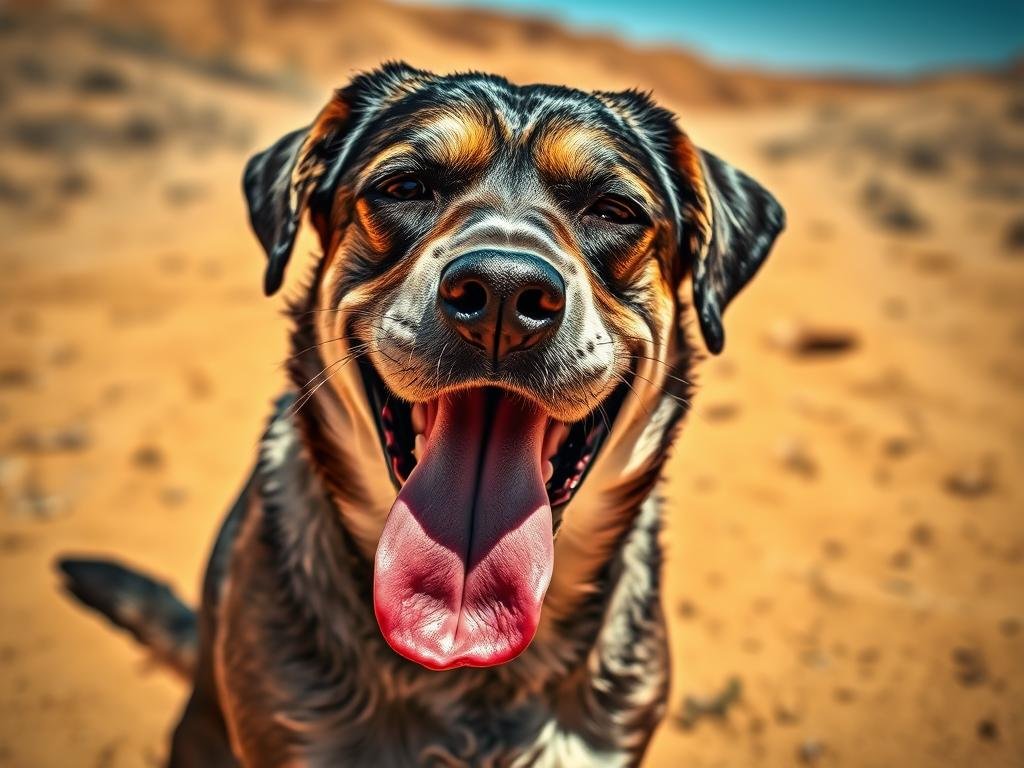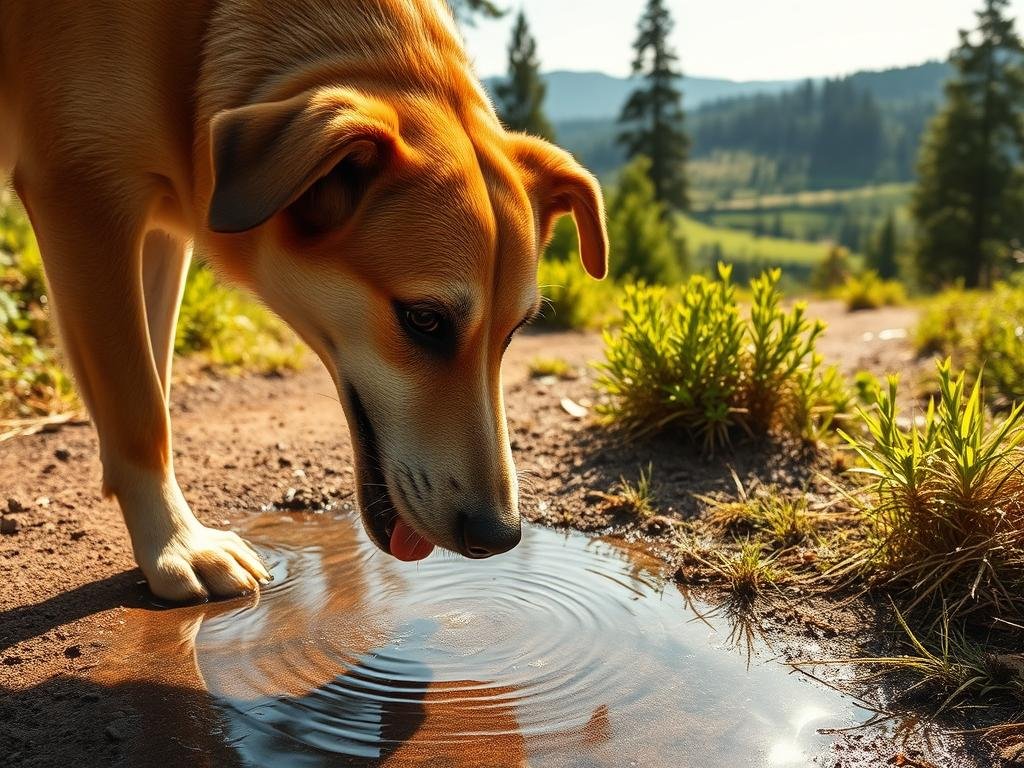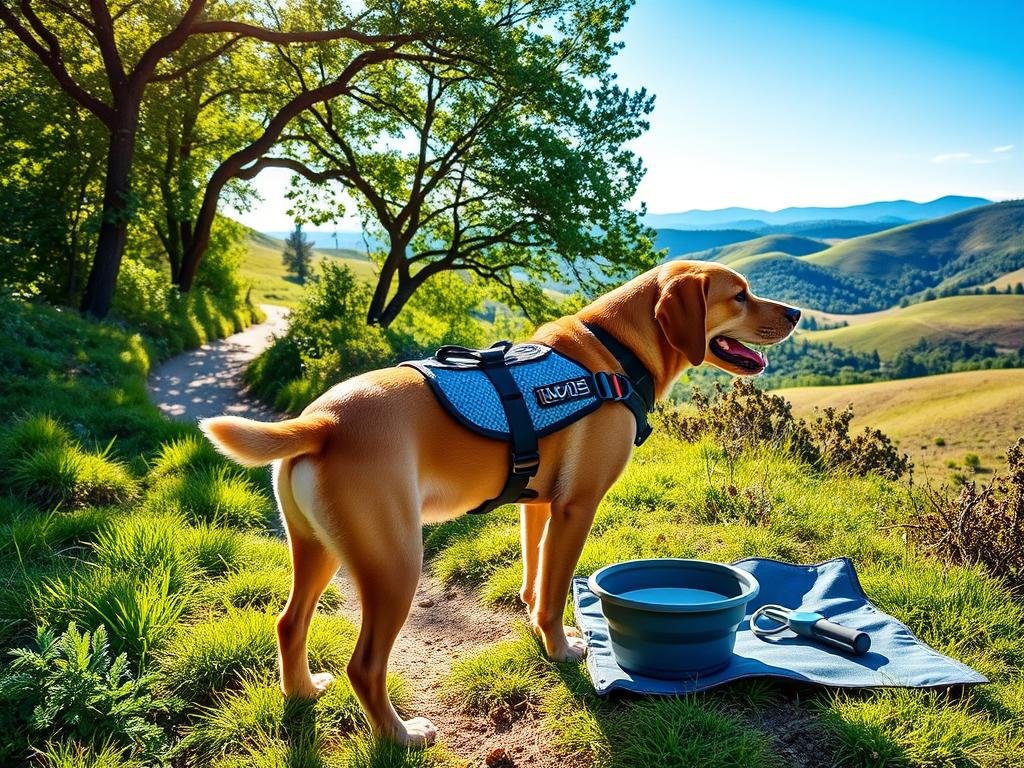Summer adventures with your furry friend can be fun, but high temperatures pose serious risks. Heatstroke affects many pets, and 1 in 7 dogs don’t survive it. Breeds like Bulldogs and Pugs face higher dangers due to breathing difficulties.
Hydration is critical—dogs need an ounce of water per pound of body weight daily. Pair this with cooling gear like vests, which can lower body temperature by 5°F. Reflective clothing or pet sunscreen also helps prevent sunburn.
Watch for warning signs: excessive panting, vomiting, or disorientation. Early action saves lives. For more trail safety tips, explore our guide on must-have hiking gear.
Table of Contents
Key Takeaways
- Heatstroke is fatal for 1 in 7 dogs.
- Brachycephalic breeds overheat faster.
- Cooling vests reduce core temperature effectively.
- Hydration needs: 1 oz water per pound daily.
- Use UPF 50+ gear for sun protection.
Why Keeping Your Dog Cool on Hikes Is Critical
Hot weather hikes demand extra caution for canine companions. Unlike humans, dogs can’t sweat efficiently, relying on panting and paw pads to regulate body temperature. This makes them prone to overheating, especially when humidity rises.

Risks of Heatstroke in Dogs
Heatstroke causes organ failure and kills 1 in 7 affected dogs. Early signs include excessive panting, bright red gums, and vomiting. Without prompt intervention, collapse or seizures may follow.
Overweight pets and those with thick fur struggle to dissipate heat. Even fit dogs face risks if the heat index surpasses safe limits.
Breeds Most Vulnerable to Overheating
Brachycephalic breeds like Bulldogs and Pugs face higher risk due to shortened airways. Chow Chows and Greyhounds also overheat faster because of dense coats or lean body mass.
Prevention is key: monitor hydration, avoid midday hikes, and use cooling gear. Recognizing symptoms early boosts survival rates to 98%.
How to Keep Your Dog Cool on Summer Hikes
Smart planning makes summer trails safer for four-legged hikers. Focus on timing, hydration, and rest to prevent overheating. These tactics work for all breeds, especially those prone to heat stress.

Timing Your Hikes for Cooler Temperatures
Early mornings or late evenings offer cooler air and softer ground. Avoid midday hikes when pavement can burn paws in just seven seconds. Pre-dawn starts are ideal for desert climates.
Check local ordinances before heading out—some trails restrict access during peak heat. Plan routes with natural shade or water sources for extra safety.
Hydration Strategies for the Trail
Pack one quart of water per three miles for active dogs. Insulated bottles keep liquids cool for hours. Electrolyte supplements help on long hikes.
Monitor gum color—pale or sticky gums signal dehydration. Carry a spray bottle to mist your dog’s coat between breaks.
Using Shade and Rest Breaks Effectively
Schedule 10-minute breaks hourly under trees or makeshift shade. Umbrellas or sunshades create instant relief spots.
Watch for overheating signs like rapid panting. Resting lowers body temperature faster than continued activity.
Essential Gear for Summer Hikes with Your Dog
The right equipment can make summer trails safer and more enjoyable for active dogs. From cooling tech to paw protection, these tools tackle heat risks head-on.

Cooling Vests and Bandanas
Ruffwear’s Swamp Cooler™ Vest lowers surface temperatures by 9.7°F in 14 minutes, thanks to evaporative technology. Pair it with a soaked neck gaiter for extra shade and cooling relief.
Gel-based alternatives work well for dry climates, while evaporative vests excel near water sources. Always check the UPF 50+ rating for sun-sensitive breeds.
Portable Water Bowls and Insulated Bottles
Silicone collapsible bowls weigh under 4 oz, fitting easily into a pack. For longer hikes, insulated bottles like Hydro Flask keep water icy for hours.
Plan for one quart per three miles. Electrolyte additives can replenish minerals lost through panting.
Protective Dog Booties for Hot Terrain
Grip Trex™ boots feature Vibram soles for traction on scorched trails and mesh uppers for airflow. Measure paw width carefully—ill-fitting booties cause blisters.
For rocky paths, opt for reinforced toes. Musher’s Secret wax shields paws on surfaces up to 120°F if booties aren’t an option.
Explore more essential hiking gear to prep for any adventure.
Recognizing Signs of Heatstroke in Dogs
Dogs show clear distress signals when overheating—knowing them is crucial. Heatstroke begins subtly but can turn fatal within minutes if ignored. Unlike heat exhaustion (fatigue, mild panting), heatstroke involves organ failure and a body temperature above 104°F.

Early Warning Signs
Watch for heavy panting, bright red gums, and uncoordinated movements. Excessive drooling or vomiting means the body is struggling. Confusion or collapse signals imminent danger—act fast.
Use a rectal thermometer to check dog temperature. Above 103°F, start cooling measures immediately. Avoid guessing; precise monitoring saves lives.
Emergency Actions to Take
Move your pet to shade and pour cool (not icy) water on their paws and belly. Fan them to speed evaporation. Never use ice baths—they shock the system.
Call your vet while cooling. Prep for ER transport: note symptoms, time exposed, and cooling steps taken. Survival rates jump from 14% to 98% with prompt care.
- Heat exhaustion: Rest, water, shade.
- Heatstroke: Cool first, then rush to the vet.
- Pack a pet first-aid kit with a thermometer and cooling towels.
Trail Etiquette and Safety Tips
Trail etiquette ensures safe and enjoyable hikes for both pets and fellow adventurers. Follow local rules, respect wildlife, and prioritize paw protection to minimize risks. Proper planning prevents accidents and preserves natural habitats.

Leash Policies and Wildlife Encounters
Many parks, like RMNP, ban dogs on 95% of trails to protect ecosystems. Use a 6-foot nylon leash—retractable ones lack control near wildlife. Train commands like “leave it” for snake or squirrel encounters.
Bury waste 8″ deep and 200 feet from water sources to prevent contamination. Carry waste bags and a first-aid kit for emergencies.
Paw Protection on Rough or Hot Surfaces
Hot terrain burns paws in seconds. Check ground temperature with your hand—if it’s too hot for you, it’s unsafe for your pet.
| Leash Type | Best For | Durability |
|---|---|---|
| Biothane | Wet climates | 5+ years |
| Climbing rope | Rocky trails | High abrasion resistance |
Apply paw wax before hikes to shield against rough surfaces. Booties with mesh uppers offer airflow and traction. Inspect paws post-hike for cuts or burns.
- Use AllTrails’ dog-friendly filters to plan routes.
- Yield to horses and hikers—step aside on narrow paths.
- Hydrate with collapsible bowls; avoid stagnant water.
Pre-Hike Preparation for Hot Weather
Getting ready for warm-weather adventures requires smart planning. Proper conditioning and health checks ensure safety for active pets. Start early to avoid last-minute problems.
Acclimating Your Dog to Warmer Temperatures
Gradual exposure helps pets adjust to rising temperatures. Begin with short walks during cooler parts of the day. Increase duration and intensity over 14 days.
Brachycephalic breeds need extra time due to breathing difficulties. Monitor panting rates and energy levels closely. Pavement tests help gauge ground safety—place your hand on surfaces for seven seconds.
| Activity | Duration | Goal |
|---|---|---|
| Morning walks | 15-20 minutes | Build endurance |
| Evening hikes | 30+ minutes | Test heat tolerance |
Vet Checkups and Fitness Assessments
Schedule a pre-hike vet visit to evaluate health risks. Bloodwork detects dehydration susceptibility. Senior dogs may need cardiac stress tests.
Ask about medications that increase heat sensitivity. Discuss paw pad toughening routines if booties aren’t preferred. For trail recommendations, explore dog-friendly summer routes.
- Hydration tests: Check gum moisture and skin elasticity.
- Weight checks: Excess pounds raise overheating risks.
- Sunscreen needs: White or thin-coated breeds require SPF protection.
Alternatives to Hiking in Extreme Heat
When temperatures soar, finding safe ways to keep pets active becomes a priority. Swap trails for creative indoor or shaded adventures to avoid heat risks. These options cater to energy levels while prioritizing safety.
Indoor Enrichment Activities
Frozen Kong toys stuffed with peanut butter lower core temperature during play. Design scentwork games by hiding ice cubes in towels—mental stimulation tires pups faster than physical exertion.
Cooling mats offer post-activity relief, while puzzle feeders slow eating and reduce boredom. Rotate toys to maintain interest on sweltering days.
Shorter Walks in Cooler Microclimates
Map shaded “cool corridors” using apps like Gaia GPS. River trails or urban parks with tree cover provide relief without sacrificing exercise.
For water-loving breeds, take dog to shallow pools or sprinklers. Always check for toxic algae blooms before swimming. Early mornings near water sources combine hydration and activity safely.
- Post-walk recovery: Use gel cooling vests or damp towels.
- Surface checks: Asphalt temps should be under 85°F for paw safety.
- Hydration hacks: Freeze broth cubes for portable treats.
Conclusion
Paws and safety go hand-in-hand when trails heat up. Recap five critical steps: hydrate with fresh water, hike during cooler hours, use cooling vests, monitor for panting, and avoid hot surfaces. Brachycephalic breeds like Bulldogs face higher risks—adjust plans accordingly.
Download our checklist for trail-ready prep. Gradually build fitness to reduce heat stress. For vet-approved gear, explore our summer essentials list.
Stay alert. With smart habits, every adventure stays safe and fun.

0 Comments